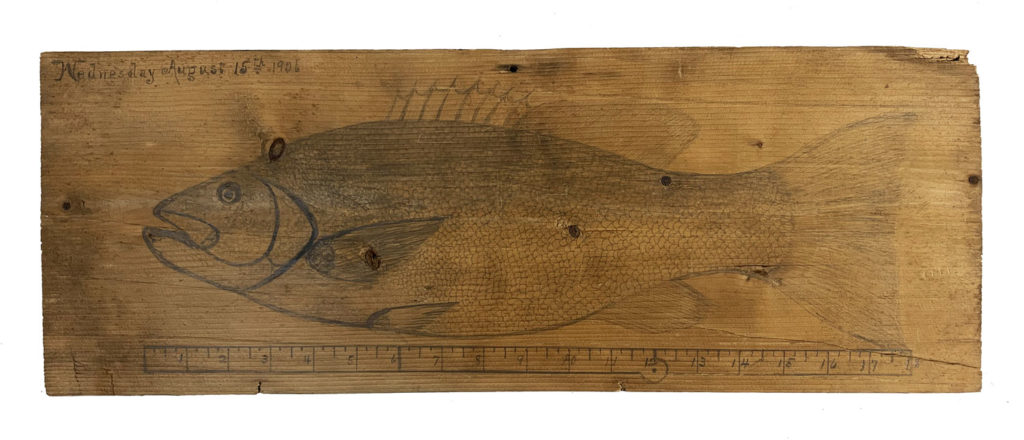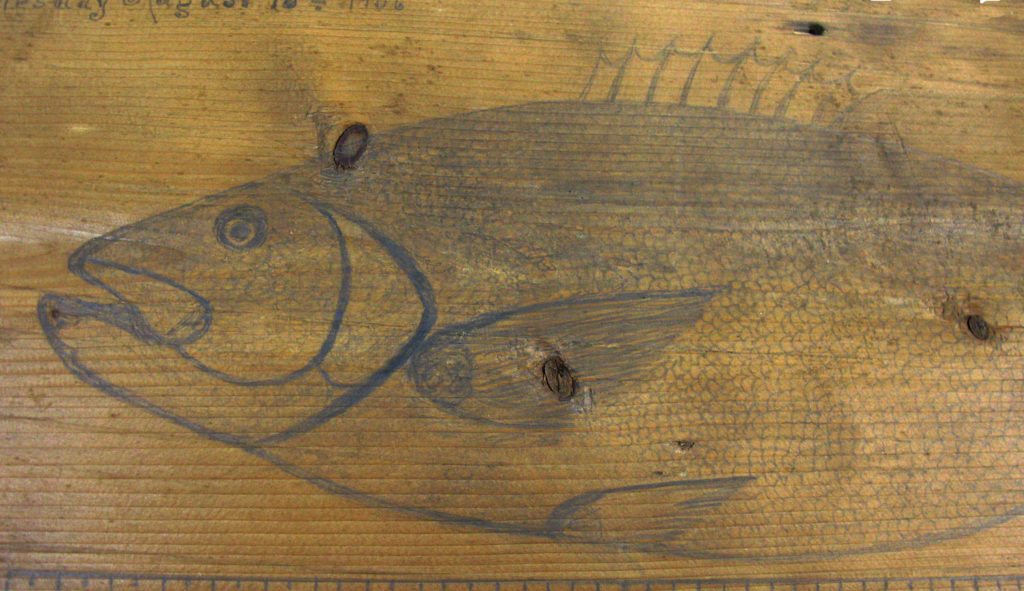Three Commemorative Fish Plaques
These fish portraits on wood commemorate three Smallmouth Bass caught in the early 20th century in New Hampshire’s Partridge Lake (near the town of Littleton, NH on the northern edge of the White Mountains bordering the Connecticut River).
They all came from the same cottage and are being sold as a collection. Two are pencil sketches and one is pyrography, and they are dated 1905 and 1906.
The largest plaque is a pencil sketch on a rectangular plank that is 22" long x 8.25" high.
The fish itself is 18” long, a size the angler must have thought impressive because there is a ruler drawn beneath the fish showing the tip of the tail at 18”.
Its penciled inscription in the upper left says “Wednesday August 15th 1906.”
The second largest plaque is 19.25" long x 6" high with a fish image that is 13" long.
This portrait is wood-burned with a pyrography tool, including the decorative border around the edges of the plaque.
An ink inscription on the back simply says “Bass 1906.”
The smallest plaque is 14.75" long x 5" high.
The pencil-drawn fish measures 12" long.
The inscription in the upper left corner says “Partridge Lake Bass July 16th 1905.”
It is hard to know if the artist/angler first traced the outlines of the actual fish and then filled in the details, or did the entire portraits freehand.
The inscriptions on the largest and smallest plaques are definitely by the same hand. The brief inscription on the back of the pyrography plaque also seems to be in the same handwriting, given how the “a” in Bass is shaped. It is likely then, that the cottage owner or one family member was an enthusiastic angler.
About Partridge Lake
The lake was originally called Partridge Pond, named after an early large landowner, Nathaniel Partridge. In the 1700s the area around the lake was sparsely settled, with just two small enterprises near the lake shore – a boarding house that rented boats and fed horses of day trippers to the lake, and a small farm.
Partridge Lake map
It was not until the early 1900s that the lake became a summer resort area and people began to build private cottages along its shores.
At that time, Partridge Pond became known as Partridge Lake, which was perhaps a rebranding to appeal to rusticators.
It is a warm water lake, with the majority of its 99 acres being between 10-30' deep, with a few spots in the center reaching 40-50’ deep. The lake still has a thriving population of Largemouth and Smallmouth Bass.
Types of Fish Commemoratives
We are attracted to all sorts of fish art, from paintings to carvings, whether they are folky representations or professionally rendered. Much of this piscine art aims to document the beauty and allure of an entire fish species, or fish in general.
In contrast, the genre of sporting art that these three plaques fit into is called commemorative art. Commemoratives are created to celebrate one very particular fish, the person who caught it, and the place, date and how it was caught.
For hundreds of years proud anglers have documented their catch with commemoratives. Sometimes commemoratives document a “trophy” fish—one that is particularly large or heavy for its species and location.
But often a fish commemorative simply aims to preserve anglers’ fond memories of an experience, such as a fishing trip, or their sentimental attachment to a special setting.
We once visited a lakeside camp in New Hampshire that had a wall covered with fish drawings on planks, each memorializing a particular fish that generations of family members had pulled from the lake over 100+ years.
While taxidermy is one way to commemorate a particular fish, drawings, paintings, carvings and cut-out silhouettes allow the catchers to have their fish and eat it, too, so to speak.
Also, these alternative methods of preserving a memory of a fish can be less expensive to produce than taxidermy, depending on whether the angler also fulfills the role of artist or has the artwork done by a professional.
Here is an overview of various types of both homemade and professional fish commemoratives from our archives of antiques that we’ve sold over the years.
1. Professional Carving
This salmon carving commemorates a salmon caught on a Scottish river in August 1898. It was created by John Tully (1862-1931) and Dhuie Tully (1862-1950), a husband and wife fish modeling team who lived in Scotland. John carved the fish that anglers brought to him to commemorate, and Dhulie painted them. They are considered to be among the finest professional artisans ever to have worked in the commemorative fish carving tradition.
2. Professional Painting
This salmon was painted on tin by a professional carriage painter named Alphonso W. Ellis. The bottom inscription reads "Caught in Weld Pond May 1886 by George D. Bisben. Length 29" Weight 11 lbs."
3. Professional Taxidermy: Skin Mounts
Captain John Waldo Nash (1862-1919) originated and patented a method of taxidermy known as a Mezzo mount, which is a fish skin mounted over a raised oval hardwood board. We bought and sold these two “Nash of Maine” mounts many years ago, but can occasionally still find original Nash mounts.
The Land-Locked Salmon backboard was inscribed: “Caught by Stuart H. Patterson spring of 1901 near Billy Soules camp Cupsuptic Lake Rangeley, Maine. Weight 7 ¼, 1 ¼ hours to land. Single strand leader.”
The Brook Trout backboard was inscribed "Caught by Stuart H. Patterson in 1903 near Senator Frye's Camp at Junction of Mosse lmegumtic and Cupsuptic Lakes, Rangeley Lake. Wt. 5 ¾ lb."
4. Folk Plaque
This plaque features a salmon profile cut from pine (perhaps made from a tracing of the actual fish) and enhanced with carved details, then mounted on a shaped and painted backboard. It is inscribed "Chinook Salmon. Caught by Lena Congdon May 11, 1941. Weight 7 lbs, Fly Grey Ghost. Guide Stewart Young, 1st Conn Lake, N.H."
5. Folk Silhouettes
These three wooden cut-outs of a salmon and two rainbow trout commemorate fish caught in April 1958 on Sunapee Lake in New Hampshire.
In recent times, traditional methods of commemorating a fish catch have given way to digital photography.
This recent “long arm shot" (holding the fish at arm’s length to exaggerate its size) shows a proud fisherman (posted on reddit.com) with a 4 lb 6 oz Smallmouth Bass caught on a New Hampshire lake not far from Partridge Lake.
While photographs can capture the beauty of a fish more accurately than other types of fish memorials, they do not have as much tactile or universal appeal as traditional commemoratives.
Historical Camp Décor
In order to imagine the context that the three Smallmouth Bass commemoratives might have resided in, we found these photos of a camp on Partridge Lake that was built in 1900, during the same time period that these commemoratives were made.
It is easy to picture a person walking down to the lake from this camp, fishing pole in hand, and walking back up holding a bass to trace.
The unfussy interior of the camp probably looks much the same in this recent photo as it did in the early decades of the 1900s. The three Smallmouth Bass fish portraits would have looked right at home on its plain board walls.
Antique commemorative fish portraits are quintessential decor for a lakeside camp, adding visual delight while also holding within them the proverbial story of a fish catch.





































